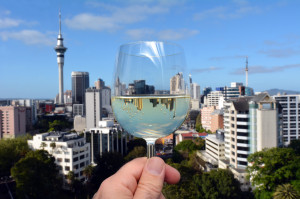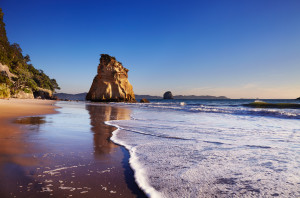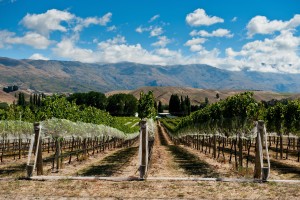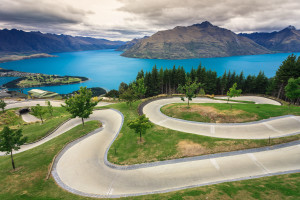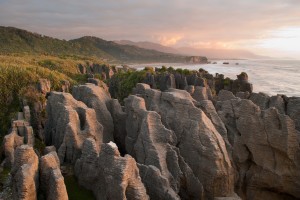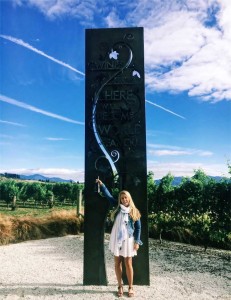Today we have a preview of a session to be presented during SWE’s 42nd Annual Conference, to be held on August 15–17, 2018 in the Finger Lakes Region of New York State. Our guest author is Christine Dalton, CSW, who tells us about her upcoming session entitled Cat Pee By Any Other Name Would Smell As Sweet: Understanding Marlborough Sauvignon Blanc.
Pick a wine-world underdog, wine that has found success under seemingly insurmountable odds. Perhaps you think of Ribiera Sacra’s delicate Mencías, made from vineyards that were left for dead during the country’s political turmoil and resurrected, only to be re-planted on vertigo-inducing slopes. Maybe your mind goes to the Canary Islands, where vines huddle for shelter amongst powerful winds and Sharpie-colored volcanic earth. Or perhaps you give a nod to the vineyards of Salta, sitting closer to the heavens than us oenophiles on Earth. Though all feats of viticultural wizardry, my choice is perhaps less obvious, purely because it is so obvious. This wine takes up large plots of real estate on grocery store shelves and has earned a reserved parking space on most by the glass lists. Yet even with this success, I consider Marlborough Sauvignon Blanc, in all its turquoise- and green-labeled glory, as a most fascinating, yet unlikely champion of the hearts and taste buds of wine lovers the world over.
Consider its origin story. New Zealand is very much a New World wine country. Vines were first planted in the early 1800s, even before it was founded as a British colony in 1853, but New Zealand didn’t find its wine footing for over a century. If we zero in on Marlborough specifically, the first Sauvignon Blanc vines that brought the region oenological fame were not planted until 1975. (To put that in context, California, another infant in the long history of winemaking, was already winning international recognition at the Judgment of Paris around the same time.) Before Montana (now Brancott Estate) planted these original vines, the consensus was that grapes could not ripen on the chilly South Island. How wrong that wisdom was, as we’ve all seen in the expeditious rise of this little experiment.
We must also consider the terroir. New Zealand sits alone in an isolated corner of the Pacific Ocean. Its closest neighbor is Australia, which lies approximately 2,000 miles away, and it is consistently pummeled by the maritime breezes bounding off the icy Tasman sea. The islands receive intense bouts of sun laced with some of the highest ultraviolet rays in the world. To intensify the extreme natural circumstances further, the country rests squarely on the boundary between the Australian and Pacific tectonic plates, which creates both geologically diverse soils and up to fifteen thousand earthquakes per year.
Then we arrive at the wine itself. Let us jump in our time machines, travel back a few hundred years and pour a goblet of Marlborough Sauvignon Blanc to the most esteemed winemakers of the Loire Valley. Would they recognize it as the grape born of their region? Or would they cast it off as a bastardized version of their time-tested style? The wine’s unique aroma and flavor profile is another enigma of its success. The novice wine drinker may not clamor for flavors of grass and bell pepper, though I doubt she would be horrified by reading these notes on the back of a label. But sweaty, stalky and punctuated by cat pee? It is difficult to imagine the success of a wine marked by these traits, yet here we are, transfixed by this wine from the Land of the Long White Cloud.
Marlborough Sauvignon Blanc is an oxymoron. It transfixes me in its unconventional conventionality. It is born of a grape known across continents, climates and time, yet is entirely idiosyncratic. It is a 20th century “invention” nudged on by a risk-taking winery, but primarily by Mother Nature herself. There were no crossings, no hybrids, no labs; there was just a revelatory eruption of pure New Zealand flavor.
What gives our lovable underdog its edge? What allows the Sauvignon Blanc grape to thrive at the end of the earth? What creates the complexity and concentration of its unique feline flavors? Scientists have a few ideas.
Winemakers and researchers have been working to unwrap its riddles since the early 2000s. The aptly titled New Zealand Sauvignon Blanc Programme is a collaboration between The Universities of Auckland and Lincoln, NZ Winegrowers and local winery partners. They have delved into the science of Sauvignon Blanc and have gained a better understanding of the chemical compounds that make up the sensory attributes of this wine. They have looked at how the unique Marlborough terroir—the cool breezes, the intense sunlight, the native yeasts and soils—creates a Sauvignon Blanc expression different than anywhere else in the world.
Their research has also revealed how much more Marlborough has to offer. To those who peg the region and its wines as one-trick-ponies, taste the differences within. Marlborough’s diversity lies in the baseball-sized river rocks of the northern Wairau Valley. These rocks absorb the sun’s powerful rays and ripen grapes that are rife with ruby red grapefruit and exotic passionfruit. Or try an intensely herbaceous expression from the windblown Awatere, which yields wines with crunchy capsicum and tomato leaves. For a revelatory treat, try an age-worthy example, like Brancott Estate’s Chosen Rows. It would be hard to imagine the Sauvignon Blanc experts of the Old World turning up their noses at a wine vibrating with so much energy and finesse.
Marlborough Sauvignon Blanc is an underdog that has already proven its success in its few decades of existence, though the region is just beginning to reveal all it has to offer. At this years’ Society of Wine Educators Conference, my mission is to inject a renewed fascination in Marlborough Sauvignon Blanc into the palates and imaginations of all who attend my seminar, Cat Pee By Any Other Name Would Smell As Sweet: Understanding Marlborough Sauvignon Blanc. We will explore the findings of the research program to better understand the wine’s unique aromas and flavors, delve into the differences between its varying subregions and taste the fine examples that have resulted from this heightened understanding of Marlborough and its beloved Sauvignon Blanc.
Christine Dalton is a member of Pernod Ricard Winemakers’ International Graduate Wine Ambassador Program, based in Southern California. As representative of the Pernod Ricard wine portfolio, she has spent time learning and working vintage in Rioja, Spain, Sonoma, California, the Barossa Valley, Australia and Marlborough, New Zealand. Originally from the Washington D.C. metro area, she previously wrote for Wine Spectator magazine as an Assistant Editor, and volunteered at the Astor Center at Astor Wines & Spirits in New York City.
She began formal wine training with an introductory wine course at Cornell University while working toward a dual degree in Government and American Studies. She is a Certified Specialist of Wine with the SWE and also holds a WSET Advanced with Distinction certification.
Christine’s session, Cat Pee By Any Other Name Would Smell As Sweet: Understanding Marlborough Sauvignon Blanc, will be offered on Wednesday, August 15, 2018 at 10:30 am as part of the 42nd Annual Conference of the Society of Wine Educators to be held in the Finger Lakes Region of New York State.
